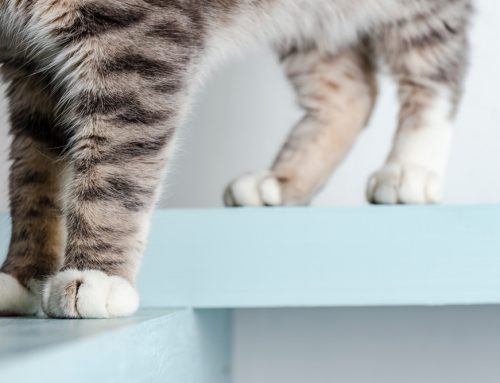Does the distant rumble of thunder cause your pet to run for cover? Perhaps the vacuum cleaner’s whirr sends them into a panic, and fireworks’ booms cause them to frantically seek out a hiding place. Noise aversion is a common but often misunderstood condition that can transform a happy and well-adjusted pet into a terrified, anxiety-ridden animal. Our Oak Creek Veterinary Care team knows that watching your pet struggle with noise aversion can be heart-wrenching, making you feel helpless. Follow our team’s tips to learn how to help your noise-averse pet cope.
Understand noise aversion in pets
The first step in helping your noise-averse pet cope is to understand the condition. While a loud, unknown sound can easily startle any pet, those with noise aversion experience extreme anxiety and fear when exposed to certain noises. A noise-averse pet’s reaction to their sound trigger is similar to a person’s reactions during a panic attack. This phobia is hard on pets and their owners, and can negatively impact an affected animal’s life, leading to behavioral and health problems. Common noise triggers include:
- Fireworks
- Thunderstorms
- Sirens
- Honking horns
- Lawn equipment
- Smoke detectors
- Vacuum cleaners
- Noisy crowds
- Kitchen appliances
Monitor your pet for distress signs
A pet’s noise-aversion signs can manifest in various ways, so watch your furry pal closely when loud sounds startle them. They may exhibit any combination of the following noise aversion signs:
- Attempting to hide or escape — Pets may seek shelter under furniture, in the basement, or in any secluded, quiet area. Some might attempt to escape the house entirely.
- Trembling or shaking — Fear or anxiety often causes physical reactions such as trembling or shaking.
- Pacing or restlessness — Your pet might become agitated and pace, seemingly unable to sit still.
- Excessive panting or drooling — Panting or drooling commonly indicates stress and anxiety.
- Decreased appetite — If your pet refuses to eat during or after a noise event, they likely suffer noise aversion.
- Vocalizing — Pets may whine, cry, or howl in response to frightening noises.
- Inappropriate urination or defecation — An extremely frightened pet may lose control of their bladder or bowels.
- Destructive behavior — In a panic, pets might chew furniture or scratch doors or walls.
- Clinginess or comfort-seeking behaviors — Some pets become overly attached and seek comfort from their owners during triggering sound events.
If your pet exhibits any of these noise aversion signs, you can help them cope. Follow these tips to help soothe your pet’s fears.
#1: Create a safe space for your pet
Designate a quiet, comfortable area in your home where your pet can retreat when they’re frightened during a triggering noise event. This could be a crate or a secluded room with comforting items such as their bed, toys, and clothing that has your scent.
#2: Distract your pet during triggering noise events
Distracting your pet during a noise event can help keep their mind engaged and distracted from the sound. Preoccupy your pet with a food-stuffed toy, long-lasting chew, or a lickable mat coated with soft food. Play nature sounds or calm classical music to help muffle loud noises.
#3: Practice behavior modification with your pet
Behavior modification involves using a variety of techniques to change a pet’s response to a particular stimulus such as a thunderstorm. Follow these behavior modification techniques:
- Desensitization — By exposing your pet to a triggering noise in a controlled manner and gradually increasing the noise intensity, your furry pal may slowly become less reactive. You can use recordings of the triggering noise or by exposing your pet to the actual noise in a controlled environment.
- Counterconditioning — This technique involves associating a triggering noise with something positive, such as a treat or a favorite toy. Over time, your pet can learn to associate the noise with the positive experience, helping reduce their fear and anxiety.
#4: Administer veterinarian-prescribed anti-anxiety medication to your pet

Pharmaceutical treatment’s goal is to reduce your pet’s anxiety level and thereby alleviate their emotional suffering and distress. Medications also increase training effectiveness, because a pet with extreme anxiety may not be capable of learning until their stress is relieved. You can administer calming supplements and medications to your pet daily or only during noise events. Consult your veterinarian to determine the most effective medication and dose for the severity of your pet’s condition.
With patience, understanding, and a proactive approach, you can help your pet learn to cope with triggering sounds and reduce their fear. If you are concerned about your pet’s response to loud noises, contact our Oak Creek Veterinary Care team.







Leave A Comment